Griffith College: 1807NRS Safe Medication Administration Report
VerifiedAdded on 2023/05/30
|12
|3279
|331
Report
AI Summary
This report examines the critical aspects of safe medication administration, as required for the 1807NRS course at Griffith College. It begins by outlining the phases of drug development and the role of the Therapeutic Goods Administration (TGA) in regulating medications in Australia, ensuring their safety and efficacy. The report then delves into the principles of pharmacokinetics and pharmacodynamics, explaining how drugs are absorbed, distributed, metabolized, and excreted, and how they interact with the body. Specific examples, such as the sublingual administration of Glyceryl Trinitrate, illustrate these concepts. The report also explores the roles and responsibilities of various healthcare professionals, including nurses, doctors, and pharmacists, in the medication cycle, emphasizing their contributions to patient safety. Furthermore, it identifies and analyzes the factors that contribute to medication errors, such as knowledge-based, rule-based, and technical errors, and discusses strategies to mitigate these risks, including the implementation of improved technology systems and the adoption of both person-centered and system-based approaches to error prevention. The report concludes by highlighting the importance of addressing distractions, providing adequate training, and fostering a culture of safety to minimize medication errors and enhance patient outcomes.
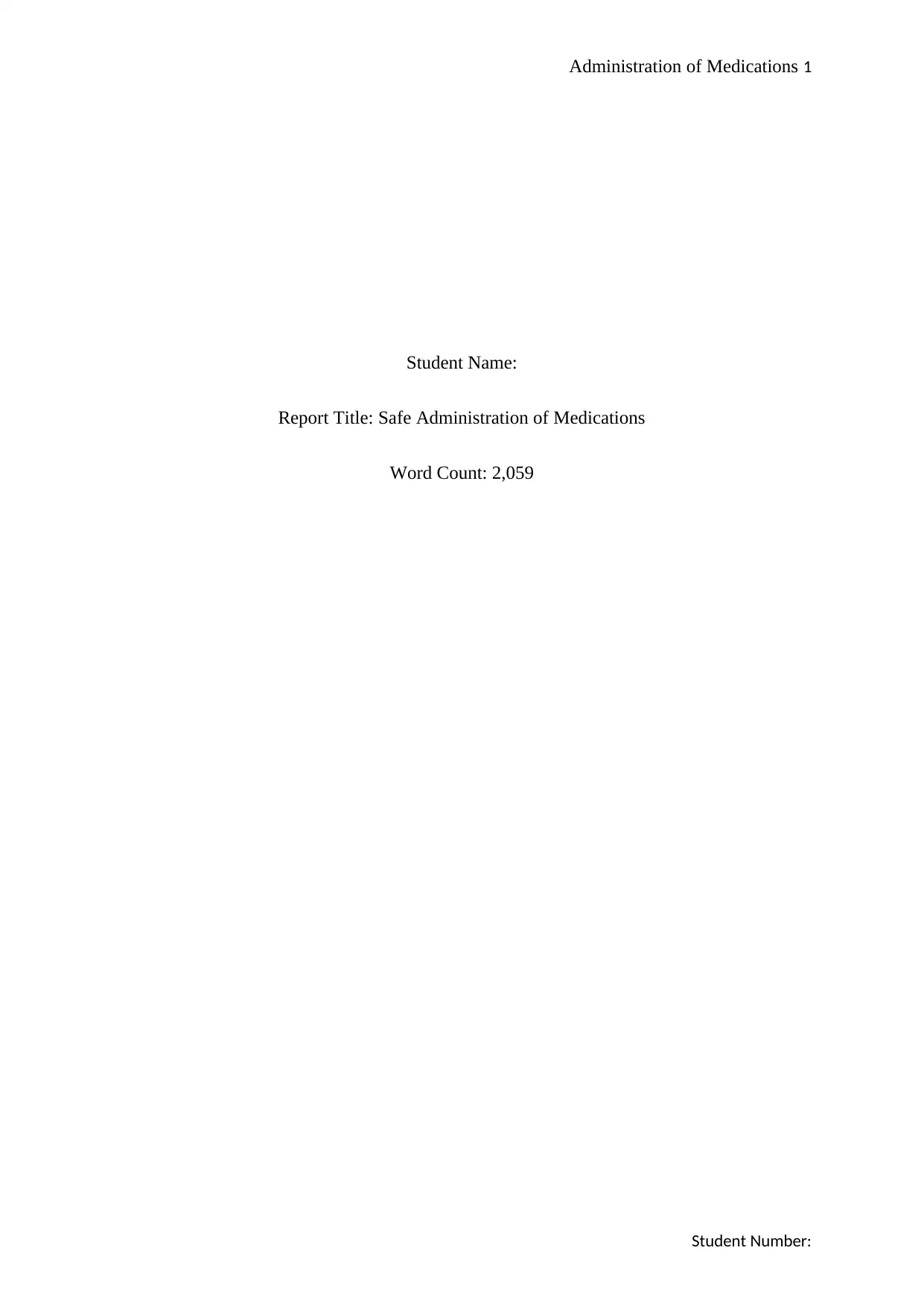
Administration of Medications 1
Student Name:
Report Title: Safe Administration of Medications
Word Count: 2,059
Student Number:
Student Name:
Report Title: Safe Administration of Medications
Word Count: 2,059
Student Number:
Paraphrase This Document
Need a fresh take? Get an instant paraphrase of this document with our AI Paraphraser
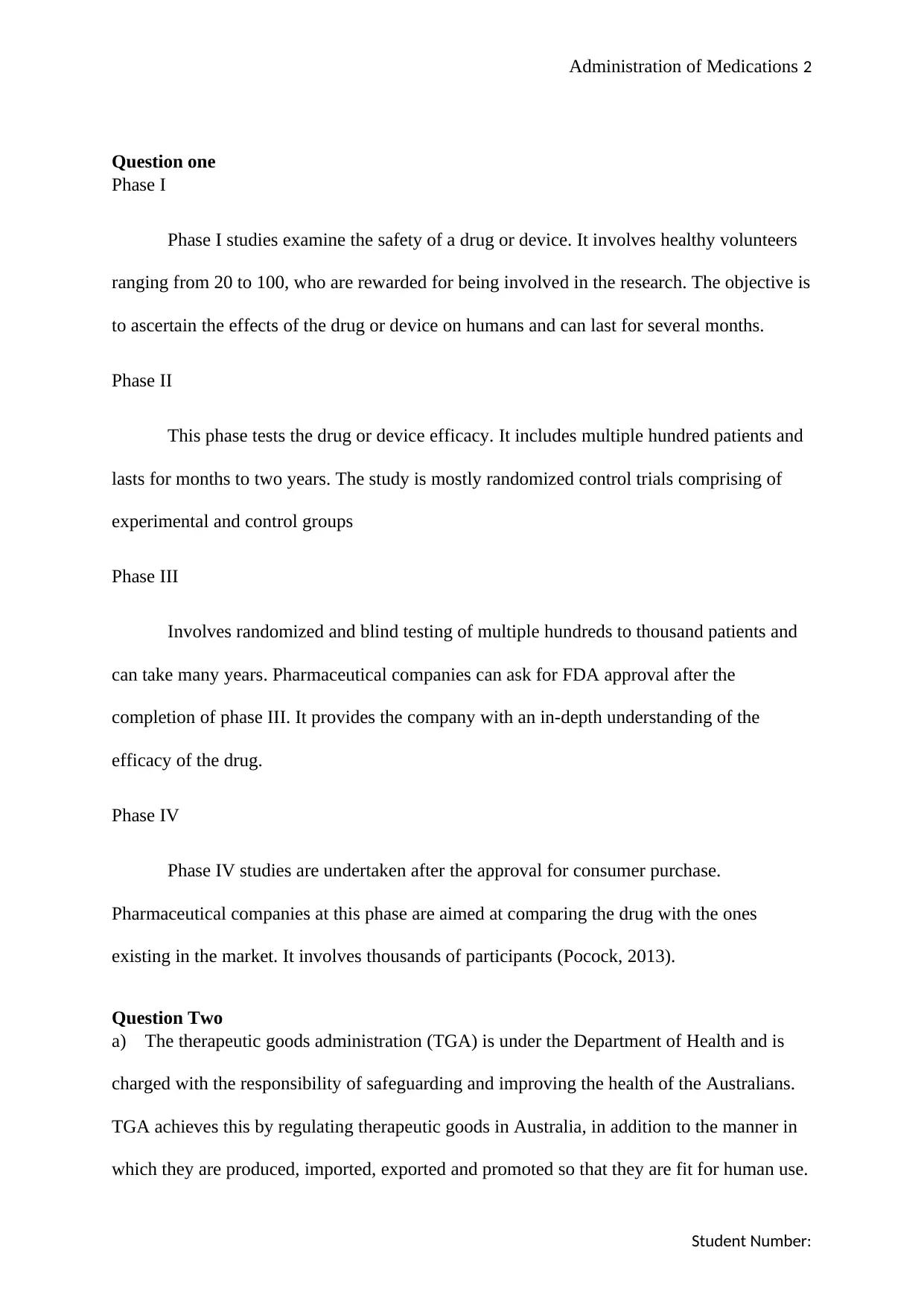
Administration of Medications 2
Question one
Phase I
Phase I studies examine the safety of a drug or device. It involves healthy volunteers
ranging from 20 to 100, who are rewarded for being involved in the research. The objective is
to ascertain the effects of the drug or device on humans and can last for several months.
Phase II
This phase tests the drug or device efficacy. It includes multiple hundred patients and
lasts for months to two years. The study is mostly randomized control trials comprising of
experimental and control groups
Phase III
Involves randomized and blind testing of multiple hundreds to thousand patients and
can take many years. Pharmaceutical companies can ask for FDA approval after the
completion of phase III. It provides the company with an in-depth understanding of the
efficacy of the drug.
Phase IV
Phase IV studies are undertaken after the approval for consumer purchase.
Pharmaceutical companies at this phase are aimed at comparing the drug with the ones
existing in the market. It involves thousands of participants (Pocock, 2013).
Question Two
a) The therapeutic goods administration (TGA) is under the Department of Health and is
charged with the responsibility of safeguarding and improving the health of the Australians.
TGA achieves this by regulating therapeutic goods in Australia, in addition to the manner in
which they are produced, imported, exported and promoted so that they are fit for human use.
Student Number:
Question one
Phase I
Phase I studies examine the safety of a drug or device. It involves healthy volunteers
ranging from 20 to 100, who are rewarded for being involved in the research. The objective is
to ascertain the effects of the drug or device on humans and can last for several months.
Phase II
This phase tests the drug or device efficacy. It includes multiple hundred patients and
lasts for months to two years. The study is mostly randomized control trials comprising of
experimental and control groups
Phase III
Involves randomized and blind testing of multiple hundreds to thousand patients and
can take many years. Pharmaceutical companies can ask for FDA approval after the
completion of phase III. It provides the company with an in-depth understanding of the
efficacy of the drug.
Phase IV
Phase IV studies are undertaken after the approval for consumer purchase.
Pharmaceutical companies at this phase are aimed at comparing the drug with the ones
existing in the market. It involves thousands of participants (Pocock, 2013).
Question Two
a) The therapeutic goods administration (TGA) is under the Department of Health and is
charged with the responsibility of safeguarding and improving the health of the Australians.
TGA achieves this by regulating therapeutic goods in Australia, in addition to the manner in
which they are produced, imported, exported and promoted so that they are fit for human use.
Student Number:
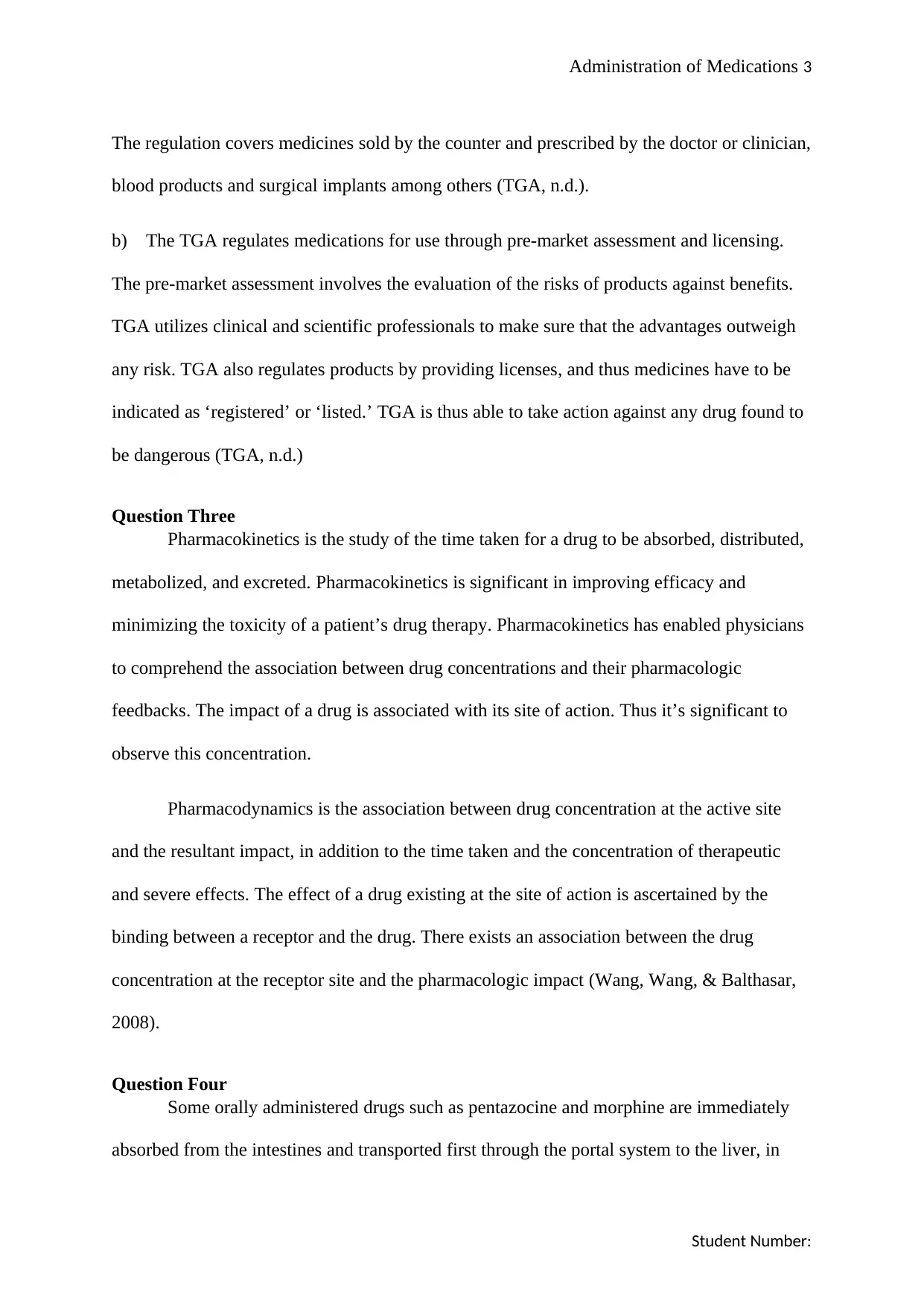
Administration of Medications 3
The regulation covers medicines sold by the counter and prescribed by the doctor or clinician,
blood products and surgical implants among others (TGA, n.d.).
b) The TGA regulates medications for use through pre-market assessment and licensing.
The pre-market assessment involves the evaluation of the risks of products against benefits.
TGA utilizes clinical and scientific professionals to make sure that the advantages outweigh
any risk. TGA also regulates products by providing licenses, and thus medicines have to be
indicated as ‘registered’ or ‘listed.’ TGA is thus able to take action against any drug found to
be dangerous (TGA, n.d.)
Question Three
Pharmacokinetics is the study of the time taken for a drug to be absorbed, distributed,
metabolized, and excreted. Pharmacokinetics is significant in improving efficacy and
minimizing the toxicity of a patient’s drug therapy. Pharmacokinetics has enabled physicians
to comprehend the association between drug concentrations and their pharmacologic
feedbacks. The impact of a drug is associated with its site of action. Thus it’s significant to
observe this concentration.
Pharmacodynamics is the association between drug concentration at the active site
and the resultant impact, in addition to the time taken and the concentration of therapeutic
and severe effects. The effect of a drug existing at the site of action is ascertained by the
binding between a receptor and the drug. There exists an association between the drug
concentration at the receptor site and the pharmacologic impact (Wang, Wang, & Balthasar,
2008).
Question Four
Some orally administered drugs such as pentazocine and morphine are immediately
absorbed from the intestines and transported first through the portal system to the liver, in
Student Number:
The regulation covers medicines sold by the counter and prescribed by the doctor or clinician,
blood products and surgical implants among others (TGA, n.d.).
b) The TGA regulates medications for use through pre-market assessment and licensing.
The pre-market assessment involves the evaluation of the risks of products against benefits.
TGA utilizes clinical and scientific professionals to make sure that the advantages outweigh
any risk. TGA also regulates products by providing licenses, and thus medicines have to be
indicated as ‘registered’ or ‘listed.’ TGA is thus able to take action against any drug found to
be dangerous (TGA, n.d.)
Question Three
Pharmacokinetics is the study of the time taken for a drug to be absorbed, distributed,
metabolized, and excreted. Pharmacokinetics is significant in improving efficacy and
minimizing the toxicity of a patient’s drug therapy. Pharmacokinetics has enabled physicians
to comprehend the association between drug concentrations and their pharmacologic
feedbacks. The impact of a drug is associated with its site of action. Thus it’s significant to
observe this concentration.
Pharmacodynamics is the association between drug concentration at the active site
and the resultant impact, in addition to the time taken and the concentration of therapeutic
and severe effects. The effect of a drug existing at the site of action is ascertained by the
binding between a receptor and the drug. There exists an association between the drug
concentration at the receptor site and the pharmacologic impact (Wang, Wang, & Balthasar,
2008).
Question Four
Some orally administered drugs such as pentazocine and morphine are immediately
absorbed from the intestines and transported first through the portal system to the liver, in
Student Number:
⊘ This is a preview!⊘
Do you want full access?
Subscribe today to unlock all pages.

Trusted by 1+ million students worldwide
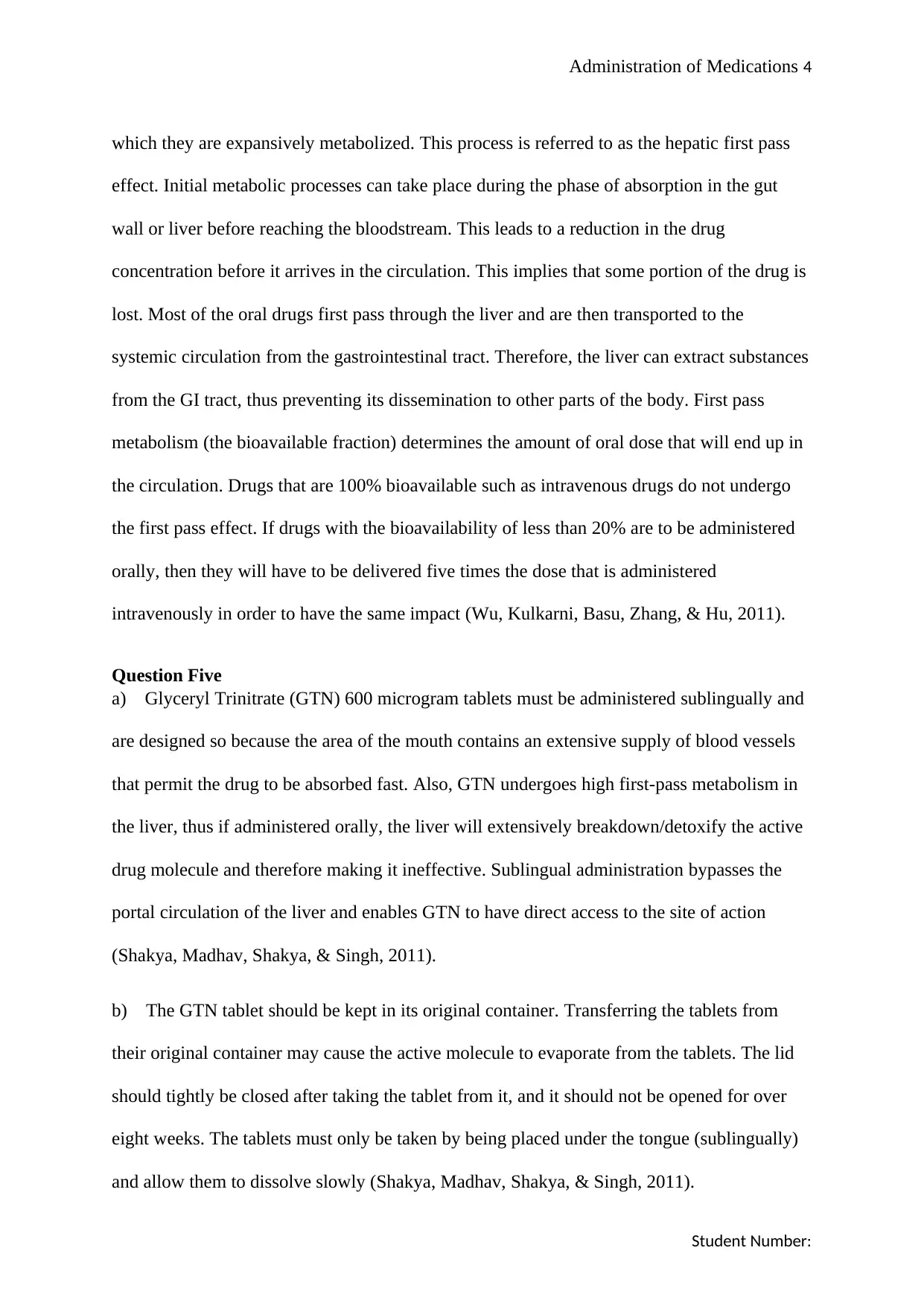
Administration of Medications 4
which they are expansively metabolized. This process is referred to as the hepatic first pass
effect. Initial metabolic processes can take place during the phase of absorption in the gut
wall or liver before reaching the bloodstream. This leads to a reduction in the drug
concentration before it arrives in the circulation. This implies that some portion of the drug is
lost. Most of the oral drugs first pass through the liver and are then transported to the
systemic circulation from the gastrointestinal tract. Therefore, the liver can extract substances
from the GI tract, thus preventing its dissemination to other parts of the body. First pass
metabolism (the bioavailable fraction) determines the amount of oral dose that will end up in
the circulation. Drugs that are 100% bioavailable such as intravenous drugs do not undergo
the first pass effect. If drugs with the bioavailability of less than 20% are to be administered
orally, then they will have to be delivered five times the dose that is administered
intravenously in order to have the same impact (Wu, Kulkarni, Basu, Zhang, & Hu, 2011).
Question Five
a) Glyceryl Trinitrate (GTN) 600 microgram tablets must be administered sublingually and
are designed so because the area of the mouth contains an extensive supply of blood vessels
that permit the drug to be absorbed fast. Also, GTN undergoes high first-pass metabolism in
the liver, thus if administered orally, the liver will extensively breakdown/detoxify the active
drug molecule and therefore making it ineffective. Sublingual administration bypasses the
portal circulation of the liver and enables GTN to have direct access to the site of action
(Shakya, Madhav, Shakya, & Singh, 2011).
b) The GTN tablet should be kept in its original container. Transferring the tablets from
their original container may cause the active molecule to evaporate from the tablets. The lid
should tightly be closed after taking the tablet from it, and it should not be opened for over
eight weeks. The tablets must only be taken by being placed under the tongue (sublingually)
and allow them to dissolve slowly (Shakya, Madhav, Shakya, & Singh, 2011).
Student Number:
which they are expansively metabolized. This process is referred to as the hepatic first pass
effect. Initial metabolic processes can take place during the phase of absorption in the gut
wall or liver before reaching the bloodstream. This leads to a reduction in the drug
concentration before it arrives in the circulation. This implies that some portion of the drug is
lost. Most of the oral drugs first pass through the liver and are then transported to the
systemic circulation from the gastrointestinal tract. Therefore, the liver can extract substances
from the GI tract, thus preventing its dissemination to other parts of the body. First pass
metabolism (the bioavailable fraction) determines the amount of oral dose that will end up in
the circulation. Drugs that are 100% bioavailable such as intravenous drugs do not undergo
the first pass effect. If drugs with the bioavailability of less than 20% are to be administered
orally, then they will have to be delivered five times the dose that is administered
intravenously in order to have the same impact (Wu, Kulkarni, Basu, Zhang, & Hu, 2011).
Question Five
a) Glyceryl Trinitrate (GTN) 600 microgram tablets must be administered sublingually and
are designed so because the area of the mouth contains an extensive supply of blood vessels
that permit the drug to be absorbed fast. Also, GTN undergoes high first-pass metabolism in
the liver, thus if administered orally, the liver will extensively breakdown/detoxify the active
drug molecule and therefore making it ineffective. Sublingual administration bypasses the
portal circulation of the liver and enables GTN to have direct access to the site of action
(Shakya, Madhav, Shakya, & Singh, 2011).
b) The GTN tablet should be kept in its original container. Transferring the tablets from
their original container may cause the active molecule to evaporate from the tablets. The lid
should tightly be closed after taking the tablet from it, and it should not be opened for over
eight weeks. The tablets must only be taken by being placed under the tongue (sublingually)
and allow them to dissolve slowly (Shakya, Madhav, Shakya, & Singh, 2011).
Student Number:
Paraphrase This Document
Need a fresh take? Get an instant paraphrase of this document with our AI Paraphraser
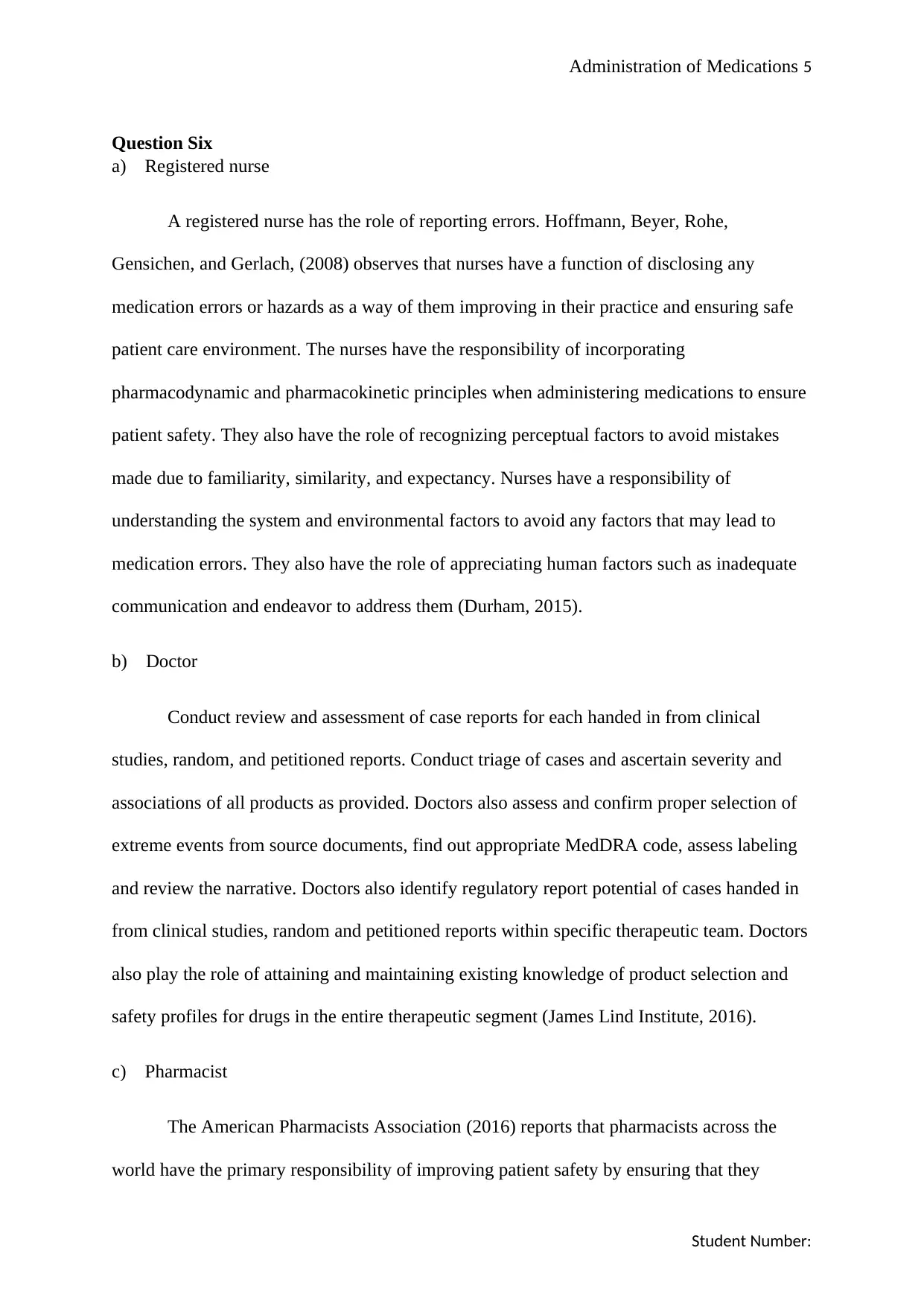
Administration of Medications 5
Question Six
a) Registered nurse
A registered nurse has the role of reporting errors. Hoffmann, Beyer, Rohe,
Gensichen, and Gerlach, (2008) observes that nurses have a function of disclosing any
medication errors or hazards as a way of them improving in their practice and ensuring safe
patient care environment. The nurses have the responsibility of incorporating
pharmacodynamic and pharmacokinetic principles when administering medications to ensure
patient safety. They also have the role of recognizing perceptual factors to avoid mistakes
made due to familiarity, similarity, and expectancy. Nurses have a responsibility of
understanding the system and environmental factors to avoid any factors that may lead to
medication errors. They also have the role of appreciating human factors such as inadequate
communication and endeavor to address them (Durham, 2015).
b) Doctor
Conduct review and assessment of case reports for each handed in from clinical
studies, random, and petitioned reports. Conduct triage of cases and ascertain severity and
associations of all products as provided. Doctors also assess and confirm proper selection of
extreme events from source documents, find out appropriate MedDRA code, assess labeling
and review the narrative. Doctors also identify regulatory report potential of cases handed in
from clinical studies, random and petitioned reports within specific therapeutic team. Doctors
also play the role of attaining and maintaining existing knowledge of product selection and
safety profiles for drugs in the entire therapeutic segment (James Lind Institute, 2016).
c) Pharmacist
The American Pharmacists Association (2016) reports that pharmacists across the
world have the primary responsibility of improving patient safety by ensuring that they
Student Number:
Question Six
a) Registered nurse
A registered nurse has the role of reporting errors. Hoffmann, Beyer, Rohe,
Gensichen, and Gerlach, (2008) observes that nurses have a function of disclosing any
medication errors or hazards as a way of them improving in their practice and ensuring safe
patient care environment. The nurses have the responsibility of incorporating
pharmacodynamic and pharmacokinetic principles when administering medications to ensure
patient safety. They also have the role of recognizing perceptual factors to avoid mistakes
made due to familiarity, similarity, and expectancy. Nurses have a responsibility of
understanding the system and environmental factors to avoid any factors that may lead to
medication errors. They also have the role of appreciating human factors such as inadequate
communication and endeavor to address them (Durham, 2015).
b) Doctor
Conduct review and assessment of case reports for each handed in from clinical
studies, random, and petitioned reports. Conduct triage of cases and ascertain severity and
associations of all products as provided. Doctors also assess and confirm proper selection of
extreme events from source documents, find out appropriate MedDRA code, assess labeling
and review the narrative. Doctors also identify regulatory report potential of cases handed in
from clinical studies, random and petitioned reports within specific therapeutic team. Doctors
also play the role of attaining and maintaining existing knowledge of product selection and
safety profiles for drugs in the entire therapeutic segment (James Lind Institute, 2016).
c) Pharmacist
The American Pharmacists Association (2016) reports that pharmacists across the
world have the primary responsibility of improving patient safety by ensuring that they
Student Number:
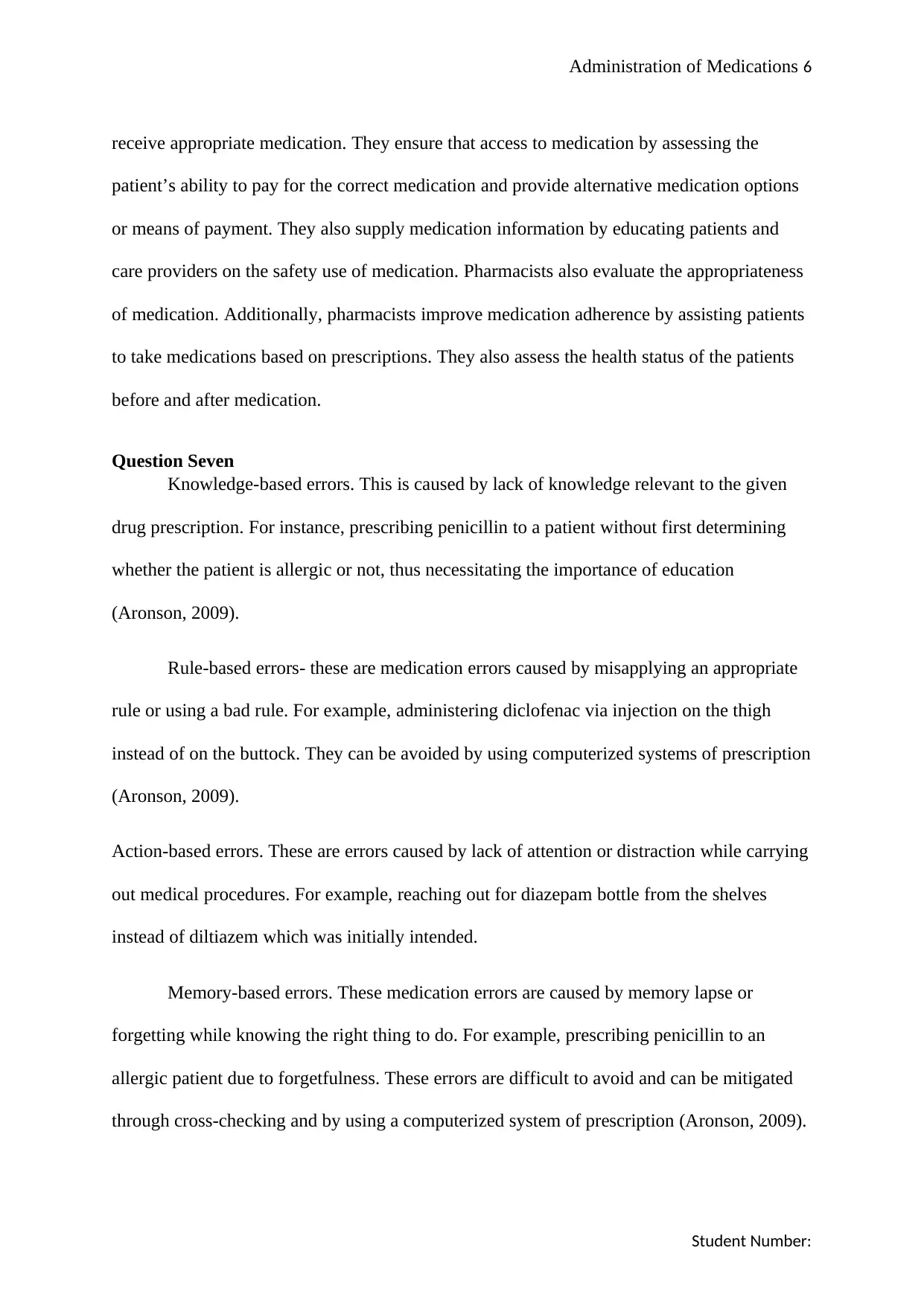
Administration of Medications 6
receive appropriate medication. They ensure that access to medication by assessing the
patient’s ability to pay for the correct medication and provide alternative medication options
or means of payment. They also supply medication information by educating patients and
care providers on the safety use of medication. Pharmacists also evaluate the appropriateness
of medication. Additionally, pharmacists improve medication adherence by assisting patients
to take medications based on prescriptions. They also assess the health status of the patients
before and after medication.
Question Seven
Knowledge-based errors. This is caused by lack of knowledge relevant to the given
drug prescription. For instance, prescribing penicillin to a patient without first determining
whether the patient is allergic or not, thus necessitating the importance of education
(Aronson, 2009).
Rule-based errors- these are medication errors caused by misapplying an appropriate
rule or using a bad rule. For example, administering diclofenac via injection on the thigh
instead of on the buttock. They can be avoided by using computerized systems of prescription
(Aronson, 2009).
Action-based errors. These are errors caused by lack of attention or distraction while carrying
out medical procedures. For example, reaching out for diazepam bottle from the shelves
instead of diltiazem which was initially intended.
Memory-based errors. These medication errors are caused by memory lapse or
forgetting while knowing the right thing to do. For example, prescribing penicillin to an
allergic patient due to forgetfulness. These errors are difficult to avoid and can be mitigated
through cross-checking and by using a computerized system of prescription (Aronson, 2009).
Student Number:
receive appropriate medication. They ensure that access to medication by assessing the
patient’s ability to pay for the correct medication and provide alternative medication options
or means of payment. They also supply medication information by educating patients and
care providers on the safety use of medication. Pharmacists also evaluate the appropriateness
of medication. Additionally, pharmacists improve medication adherence by assisting patients
to take medications based on prescriptions. They also assess the health status of the patients
before and after medication.
Question Seven
Knowledge-based errors. This is caused by lack of knowledge relevant to the given
drug prescription. For instance, prescribing penicillin to a patient without first determining
whether the patient is allergic or not, thus necessitating the importance of education
(Aronson, 2009).
Rule-based errors- these are medication errors caused by misapplying an appropriate
rule or using a bad rule. For example, administering diclofenac via injection on the thigh
instead of on the buttock. They can be avoided by using computerized systems of prescription
(Aronson, 2009).
Action-based errors. These are errors caused by lack of attention or distraction while carrying
out medical procedures. For example, reaching out for diazepam bottle from the shelves
instead of diltiazem which was initially intended.
Memory-based errors. These medication errors are caused by memory lapse or
forgetting while knowing the right thing to do. For example, prescribing penicillin to an
allergic patient due to forgetfulness. These errors are difficult to avoid and can be mitigated
through cross-checking and by using a computerized system of prescription (Aronson, 2009).
Student Number:
⊘ This is a preview!⊘
Do you want full access?
Subscribe today to unlock all pages.

Trusted by 1+ million students worldwide
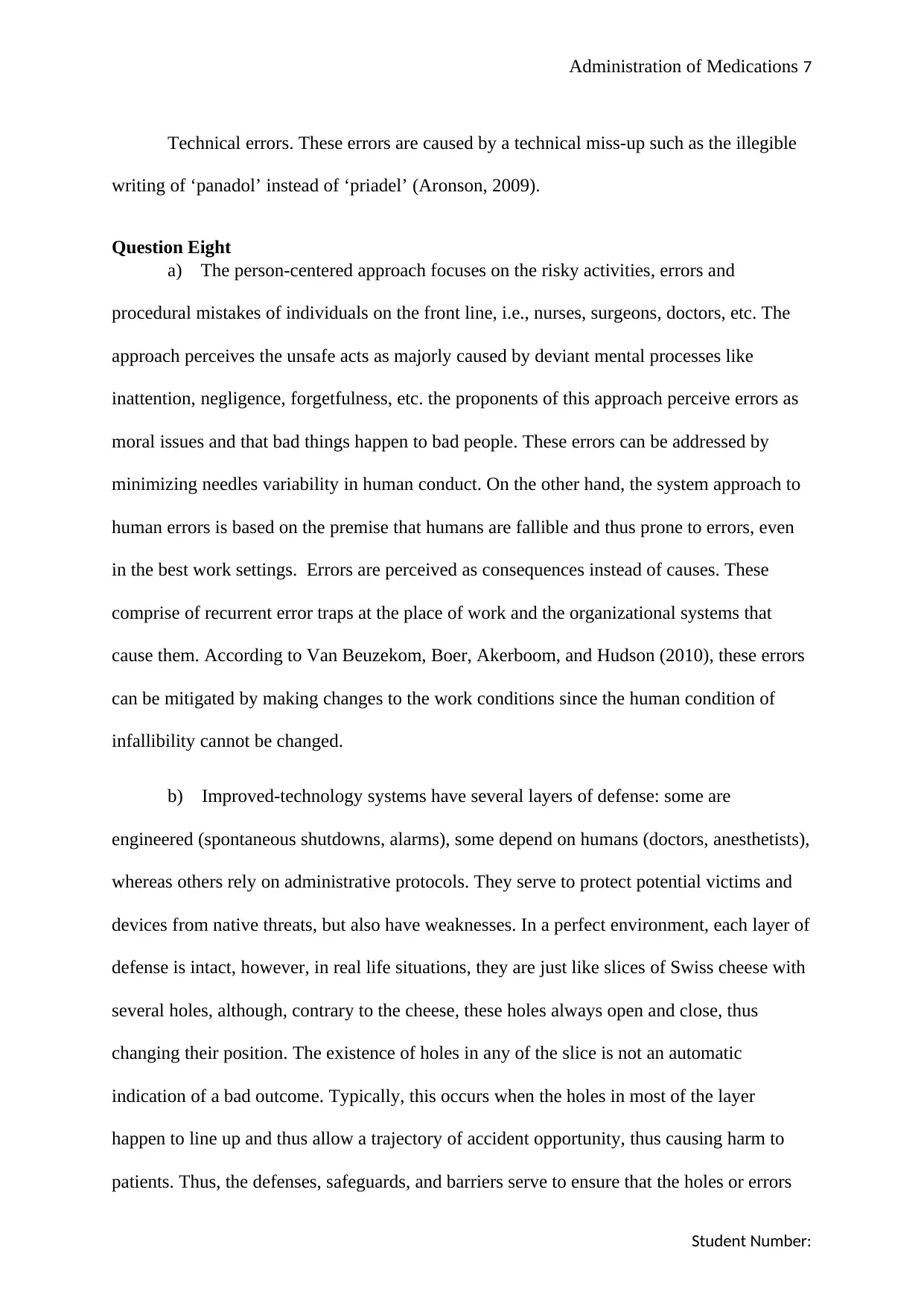
Administration of Medications 7
Technical errors. These errors are caused by a technical miss-up such as the illegible
writing of ‘panadol’ instead of ‘priadel’ (Aronson, 2009).
Question Eight
a) The person-centered approach focuses on the risky activities, errors and
procedural mistakes of individuals on the front line, i.e., nurses, surgeons, doctors, etc. The
approach perceives the unsafe acts as majorly caused by deviant mental processes like
inattention, negligence, forgetfulness, etc. the proponents of this approach perceive errors as
moral issues and that bad things happen to bad people. These errors can be addressed by
minimizing needles variability in human conduct. On the other hand, the system approach to
human errors is based on the premise that humans are fallible and thus prone to errors, even
in the best work settings. Errors are perceived as consequences instead of causes. These
comprise of recurrent error traps at the place of work and the organizational systems that
cause them. According to Van Beuzekom, Boer, Akerboom, and Hudson (2010), these errors
can be mitigated by making changes to the work conditions since the human condition of
infallibility cannot be changed.
b) Improved-technology systems have several layers of defense: some are
engineered (spontaneous shutdowns, alarms), some depend on humans (doctors, anesthetists),
whereas others rely on administrative protocols. They serve to protect potential victims and
devices from native threats, but also have weaknesses. In a perfect environment, each layer of
defense is intact, however, in real life situations, they are just like slices of Swiss cheese with
several holes, although, contrary to the cheese, these holes always open and close, thus
changing their position. The existence of holes in any of the slice is not an automatic
indication of a bad outcome. Typically, this occurs when the holes in most of the layer
happen to line up and thus allow a trajectory of accident opportunity, thus causing harm to
patients. Thus, the defenses, safeguards, and barriers serve to ensure that the holes or errors
Student Number:
Technical errors. These errors are caused by a technical miss-up such as the illegible
writing of ‘panadol’ instead of ‘priadel’ (Aronson, 2009).
Question Eight
a) The person-centered approach focuses on the risky activities, errors and
procedural mistakes of individuals on the front line, i.e., nurses, surgeons, doctors, etc. The
approach perceives the unsafe acts as majorly caused by deviant mental processes like
inattention, negligence, forgetfulness, etc. the proponents of this approach perceive errors as
moral issues and that bad things happen to bad people. These errors can be addressed by
minimizing needles variability in human conduct. On the other hand, the system approach to
human errors is based on the premise that humans are fallible and thus prone to errors, even
in the best work settings. Errors are perceived as consequences instead of causes. These
comprise of recurrent error traps at the place of work and the organizational systems that
cause them. According to Van Beuzekom, Boer, Akerboom, and Hudson (2010), these errors
can be mitigated by making changes to the work conditions since the human condition of
infallibility cannot be changed.
b) Improved-technology systems have several layers of defense: some are
engineered (spontaneous shutdowns, alarms), some depend on humans (doctors, anesthetists),
whereas others rely on administrative protocols. They serve to protect potential victims and
devices from native threats, but also have weaknesses. In a perfect environment, each layer of
defense is intact, however, in real life situations, they are just like slices of Swiss cheese with
several holes, although, contrary to the cheese, these holes always open and close, thus
changing their position. The existence of holes in any of the slice is not an automatic
indication of a bad outcome. Typically, this occurs when the holes in most of the layer
happen to line up and thus allow a trajectory of accident opportunity, thus causing harm to
patients. Thus, the defenses, safeguards, and barriers serve to ensure that the holes or errors
Student Number:
Paraphrase This Document
Need a fresh take? Get an instant paraphrase of this document with our AI Paraphraser
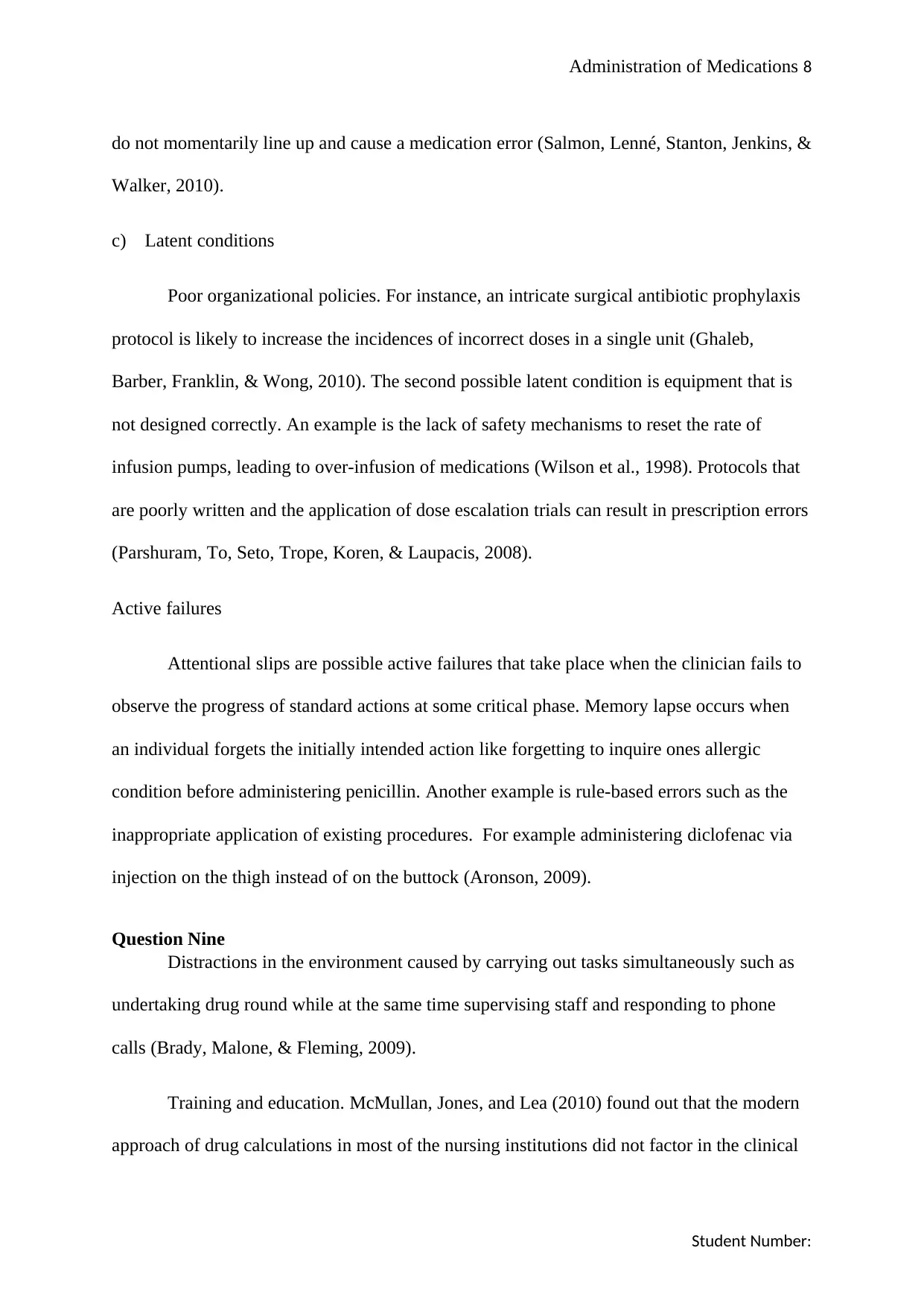
Administration of Medications 8
do not momentarily line up and cause a medication error (Salmon, Lenné, Stanton, Jenkins, &
Walker, 2010).
c) Latent conditions
Poor organizational policies. For instance, an intricate surgical antibiotic prophylaxis
protocol is likely to increase the incidences of incorrect doses in a single unit (Ghaleb,
Barber, Franklin, & Wong, 2010). The second possible latent condition is equipment that is
not designed correctly. An example is the lack of safety mechanisms to reset the rate of
infusion pumps, leading to over-infusion of medications (Wilson et al., 1998). Protocols that
are poorly written and the application of dose escalation trials can result in prescription errors
(Parshuram, To, Seto, Trope, Koren, & Laupacis, 2008).
Active failures
Attentional slips are possible active failures that take place when the clinician fails to
observe the progress of standard actions at some critical phase. Memory lapse occurs when
an individual forgets the initially intended action like forgetting to inquire ones allergic
condition before administering penicillin. Another example is rule-based errors such as the
inappropriate application of existing procedures. For example administering diclofenac via
injection on the thigh instead of on the buttock (Aronson, 2009).
Question Nine
Distractions in the environment caused by carrying out tasks simultaneously such as
undertaking drug round while at the same time supervising staff and responding to phone
calls (Brady, Malone, & Fleming, 2009).
Training and education. McMullan, Jones, and Lea (2010) found out that the modern
approach of drug calculations in most of the nursing institutions did not factor in the clinical
Student Number:
do not momentarily line up and cause a medication error (Salmon, Lenné, Stanton, Jenkins, &
Walker, 2010).
c) Latent conditions
Poor organizational policies. For instance, an intricate surgical antibiotic prophylaxis
protocol is likely to increase the incidences of incorrect doses in a single unit (Ghaleb,
Barber, Franklin, & Wong, 2010). The second possible latent condition is equipment that is
not designed correctly. An example is the lack of safety mechanisms to reset the rate of
infusion pumps, leading to over-infusion of medications (Wilson et al., 1998). Protocols that
are poorly written and the application of dose escalation trials can result in prescription errors
(Parshuram, To, Seto, Trope, Koren, & Laupacis, 2008).
Active failures
Attentional slips are possible active failures that take place when the clinician fails to
observe the progress of standard actions at some critical phase. Memory lapse occurs when
an individual forgets the initially intended action like forgetting to inquire ones allergic
condition before administering penicillin. Another example is rule-based errors such as the
inappropriate application of existing procedures. For example administering diclofenac via
injection on the thigh instead of on the buttock (Aronson, 2009).
Question Nine
Distractions in the environment caused by carrying out tasks simultaneously such as
undertaking drug round while at the same time supervising staff and responding to phone
calls (Brady, Malone, & Fleming, 2009).
Training and education. McMullan, Jones, and Lea (2010) found out that the modern
approach of drug calculations in most of the nursing institutions did not factor in the clinical
Student Number:
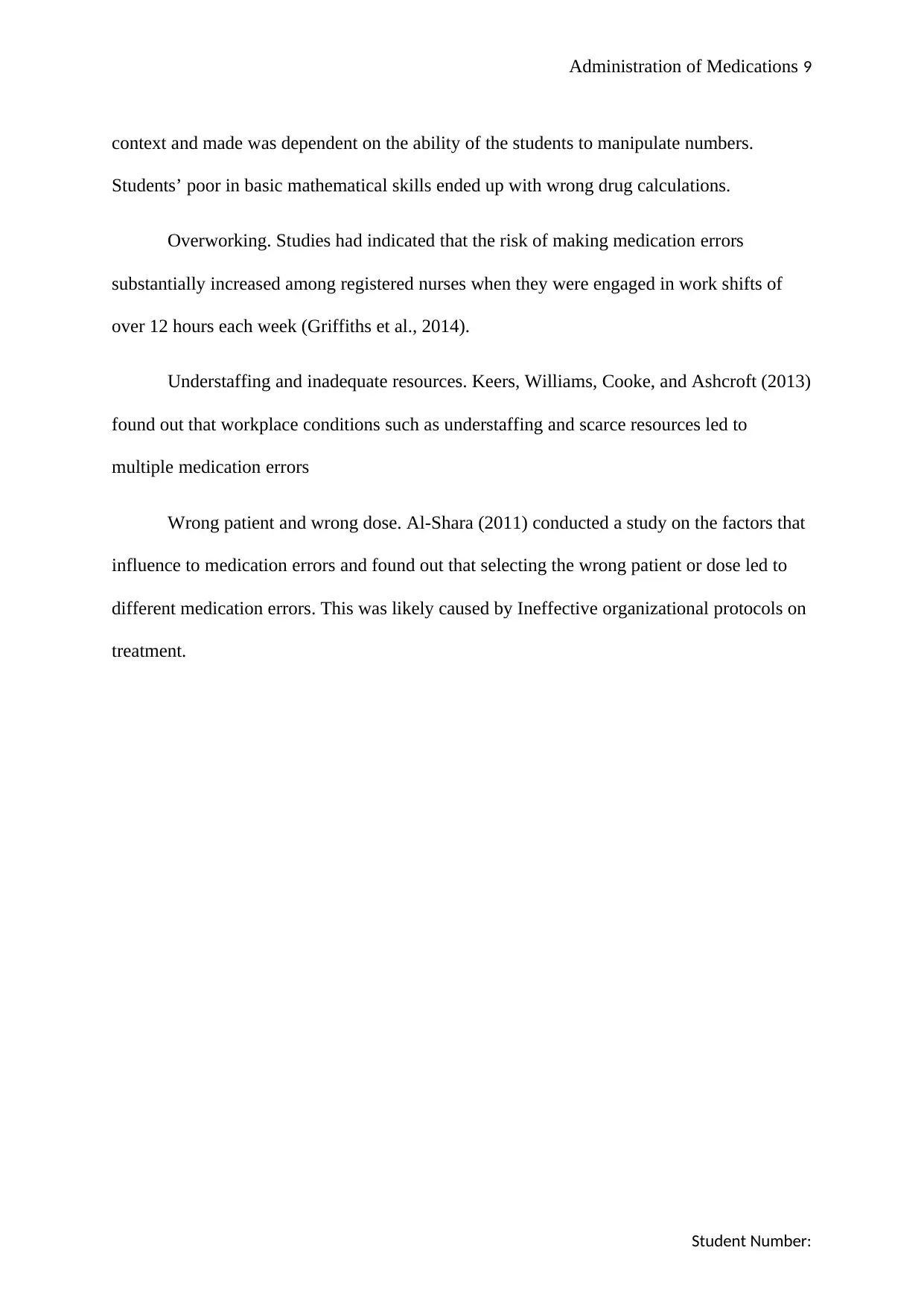
Administration of Medications 9
context and made was dependent on the ability of the students to manipulate numbers.
Students’ poor in basic mathematical skills ended up with wrong drug calculations.
Overworking. Studies had indicated that the risk of making medication errors
substantially increased among registered nurses when they were engaged in work shifts of
over 12 hours each week (Griffiths et al., 2014).
Understaffing and inadequate resources. Keers, Williams, Cooke, and Ashcroft (2013)
found out that workplace conditions such as understaffing and scarce resources led to
multiple medication errors
Wrong patient and wrong dose. Al-Shara (2011) conducted a study on the factors that
influence to medication errors and found out that selecting the wrong patient or dose led to
different medication errors. This was likely caused by Ineffective organizational protocols on
treatment.
Student Number:
context and made was dependent on the ability of the students to manipulate numbers.
Students’ poor in basic mathematical skills ended up with wrong drug calculations.
Overworking. Studies had indicated that the risk of making medication errors
substantially increased among registered nurses when they were engaged in work shifts of
over 12 hours each week (Griffiths et al., 2014).
Understaffing and inadequate resources. Keers, Williams, Cooke, and Ashcroft (2013)
found out that workplace conditions such as understaffing and scarce resources led to
multiple medication errors
Wrong patient and wrong dose. Al-Shara (2011) conducted a study on the factors that
influence to medication errors and found out that selecting the wrong patient or dose led to
different medication errors. This was likely caused by Ineffective organizational protocols on
treatment.
Student Number:
⊘ This is a preview!⊘
Do you want full access?
Subscribe today to unlock all pages.

Trusted by 1+ million students worldwide
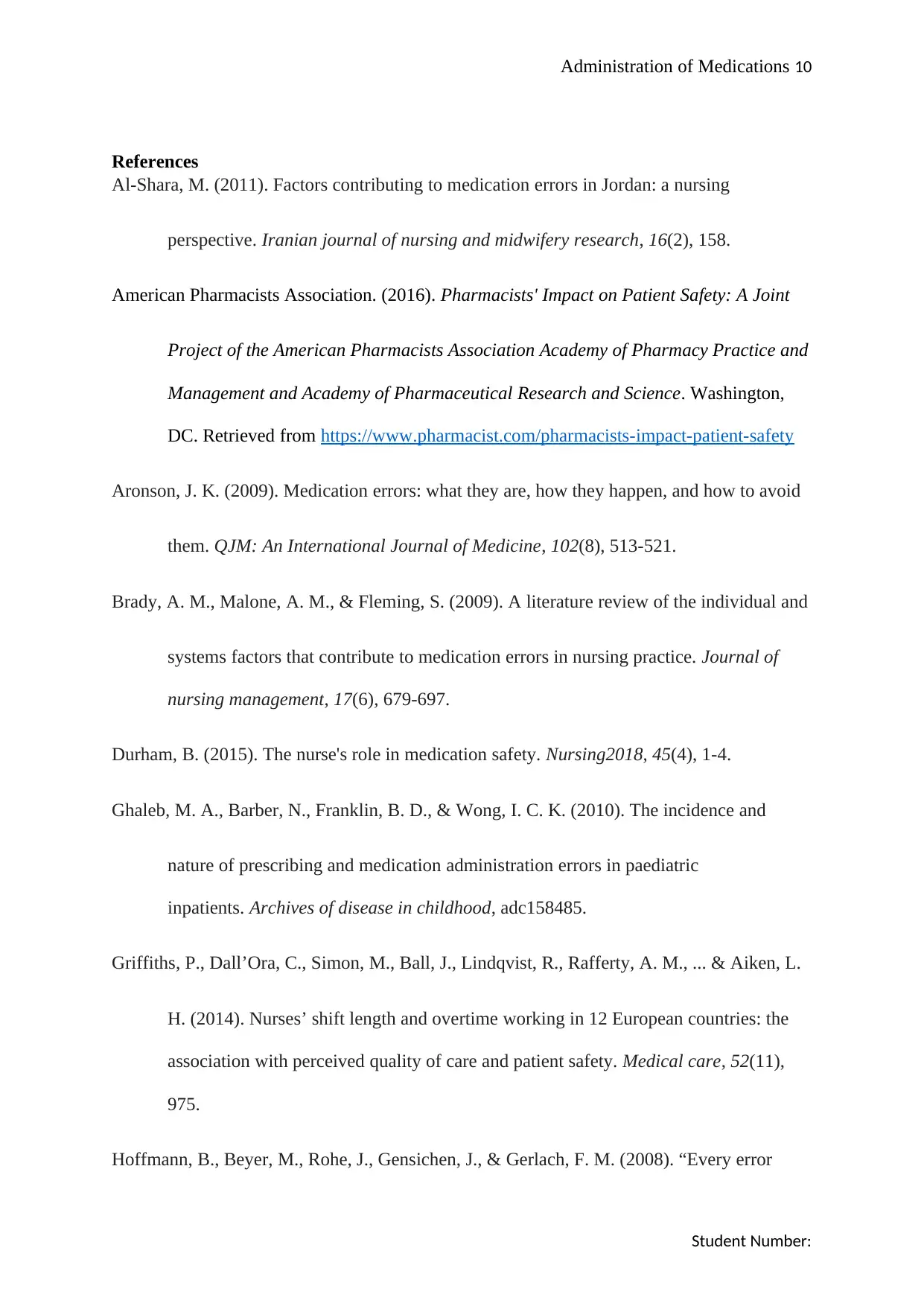
Administration of Medications 10
References
Al-Shara, M. (2011). Factors contributing to medication errors in Jordan: a nursing
perspective. Iranian journal of nursing and midwifery research, 16(2), 158.
American Pharmacists Association. (2016). Pharmacists' Impact on Patient Safety: A Joint
Project of the American Pharmacists Association Academy of Pharmacy Practice and
Management and Academy of Pharmaceutical Research and Science. Washington,
DC. Retrieved from https://www.pharmacist.com/pharmacists-impact-patient-safety
Aronson, J. K. (2009). Medication errors: what they are, how they happen, and how to avoid
them. QJM: An International Journal of Medicine, 102(8), 513-521.
Brady, A. M., Malone, A. M., & Fleming, S. (2009). A literature review of the individual and
systems factors that contribute to medication errors in nursing practice. Journal of
nursing management, 17(6), 679-697.
Durham, B. (2015). The nurse's role in medication safety. Nursing2018, 45(4), 1-4.
Ghaleb, M. A., Barber, N., Franklin, B. D., & Wong, I. C. K. (2010). The incidence and
nature of prescribing and medication administration errors in paediatric
inpatients. Archives of disease in childhood, adc158485.
Griffiths, P., Dall’Ora, C., Simon, M., Ball, J., Lindqvist, R., Rafferty, A. M., ... & Aiken, L.
H. (2014). Nurses’ shift length and overtime working in 12 European countries: the
association with perceived quality of care and patient safety. Medical care, 52(11),
975.
Hoffmann, B., Beyer, M., Rohe, J., Gensichen, J., & Gerlach, F. M. (2008). “Every error
Student Number:
References
Al-Shara, M. (2011). Factors contributing to medication errors in Jordan: a nursing
perspective. Iranian journal of nursing and midwifery research, 16(2), 158.
American Pharmacists Association. (2016). Pharmacists' Impact on Patient Safety: A Joint
Project of the American Pharmacists Association Academy of Pharmacy Practice and
Management and Academy of Pharmaceutical Research and Science. Washington,
DC. Retrieved from https://www.pharmacist.com/pharmacists-impact-patient-safety
Aronson, J. K. (2009). Medication errors: what they are, how they happen, and how to avoid
them. QJM: An International Journal of Medicine, 102(8), 513-521.
Brady, A. M., Malone, A. M., & Fleming, S. (2009). A literature review of the individual and
systems factors that contribute to medication errors in nursing practice. Journal of
nursing management, 17(6), 679-697.
Durham, B. (2015). The nurse's role in medication safety. Nursing2018, 45(4), 1-4.
Ghaleb, M. A., Barber, N., Franklin, B. D., & Wong, I. C. K. (2010). The incidence and
nature of prescribing and medication administration errors in paediatric
inpatients. Archives of disease in childhood, adc158485.
Griffiths, P., Dall’Ora, C., Simon, M., Ball, J., Lindqvist, R., Rafferty, A. M., ... & Aiken, L.
H. (2014). Nurses’ shift length and overtime working in 12 European countries: the
association with perceived quality of care and patient safety. Medical care, 52(11),
975.
Hoffmann, B., Beyer, M., Rohe, J., Gensichen, J., & Gerlach, F. M. (2008). “Every error
Student Number:
Paraphrase This Document
Need a fresh take? Get an instant paraphrase of this document with our AI Paraphraser
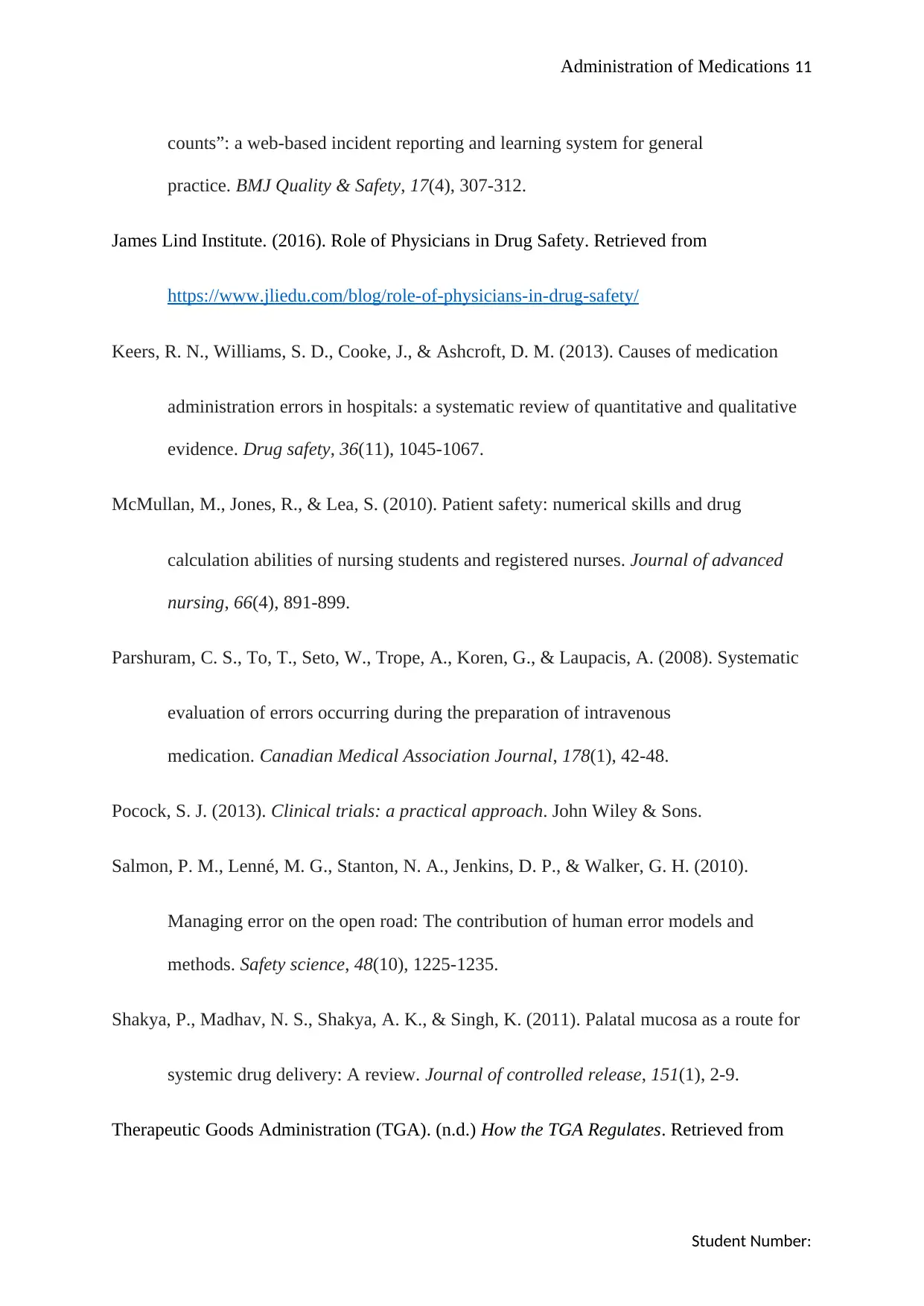
Administration of Medications 11
counts”: a web-based incident reporting and learning system for general
practice. BMJ Quality & Safety, 17(4), 307-312.
James Lind Institute. (2016). Role of Physicians in Drug Safety. Retrieved from
https://www.jliedu.com/blog/role-of-physicians-in-drug-safety/
Keers, R. N., Williams, S. D., Cooke, J., & Ashcroft, D. M. (2013). Causes of medication
administration errors in hospitals: a systematic review of quantitative and qualitative
evidence. Drug safety, 36(11), 1045-1067.
McMullan, M., Jones, R., & Lea, S. (2010). Patient safety: numerical skills and drug
calculation abilities of nursing students and registered nurses. Journal of advanced
nursing, 66(4), 891-899.
Parshuram, C. S., To, T., Seto, W., Trope, A., Koren, G., & Laupacis, A. (2008). Systematic
evaluation of errors occurring during the preparation of intravenous
medication. Canadian Medical Association Journal, 178(1), 42-48.
Pocock, S. J. (2013). Clinical trials: a practical approach. John Wiley & Sons.
Salmon, P. M., Lenné, M. G., Stanton, N. A., Jenkins, D. P., & Walker, G. H. (2010).
Managing error on the open road: The contribution of human error models and
methods. Safety science, 48(10), 1225-1235.
Shakya, P., Madhav, N. S., Shakya, A. K., & Singh, K. (2011). Palatal mucosa as a route for
systemic drug delivery: A review. Journal of controlled release, 151(1), 2-9.
Therapeutic Goods Administration (TGA). (n.d.) How the TGA Regulates. Retrieved from
Student Number:
counts”: a web-based incident reporting and learning system for general
practice. BMJ Quality & Safety, 17(4), 307-312.
James Lind Institute. (2016). Role of Physicians in Drug Safety. Retrieved from
https://www.jliedu.com/blog/role-of-physicians-in-drug-safety/
Keers, R. N., Williams, S. D., Cooke, J., & Ashcroft, D. M. (2013). Causes of medication
administration errors in hospitals: a systematic review of quantitative and qualitative
evidence. Drug safety, 36(11), 1045-1067.
McMullan, M., Jones, R., & Lea, S. (2010). Patient safety: numerical skills and drug
calculation abilities of nursing students and registered nurses. Journal of advanced
nursing, 66(4), 891-899.
Parshuram, C. S., To, T., Seto, W., Trope, A., Koren, G., & Laupacis, A. (2008). Systematic
evaluation of errors occurring during the preparation of intravenous
medication. Canadian Medical Association Journal, 178(1), 42-48.
Pocock, S. J. (2013). Clinical trials: a practical approach. John Wiley & Sons.
Salmon, P. M., Lenné, M. G., Stanton, N. A., Jenkins, D. P., & Walker, G. H. (2010).
Managing error on the open road: The contribution of human error models and
methods. Safety science, 48(10), 1225-1235.
Shakya, P., Madhav, N. S., Shakya, A. K., & Singh, K. (2011). Palatal mucosa as a route for
systemic drug delivery: A review. Journal of controlled release, 151(1), 2-9.
Therapeutic Goods Administration (TGA). (n.d.) How the TGA Regulates. Retrieved from
Student Number:
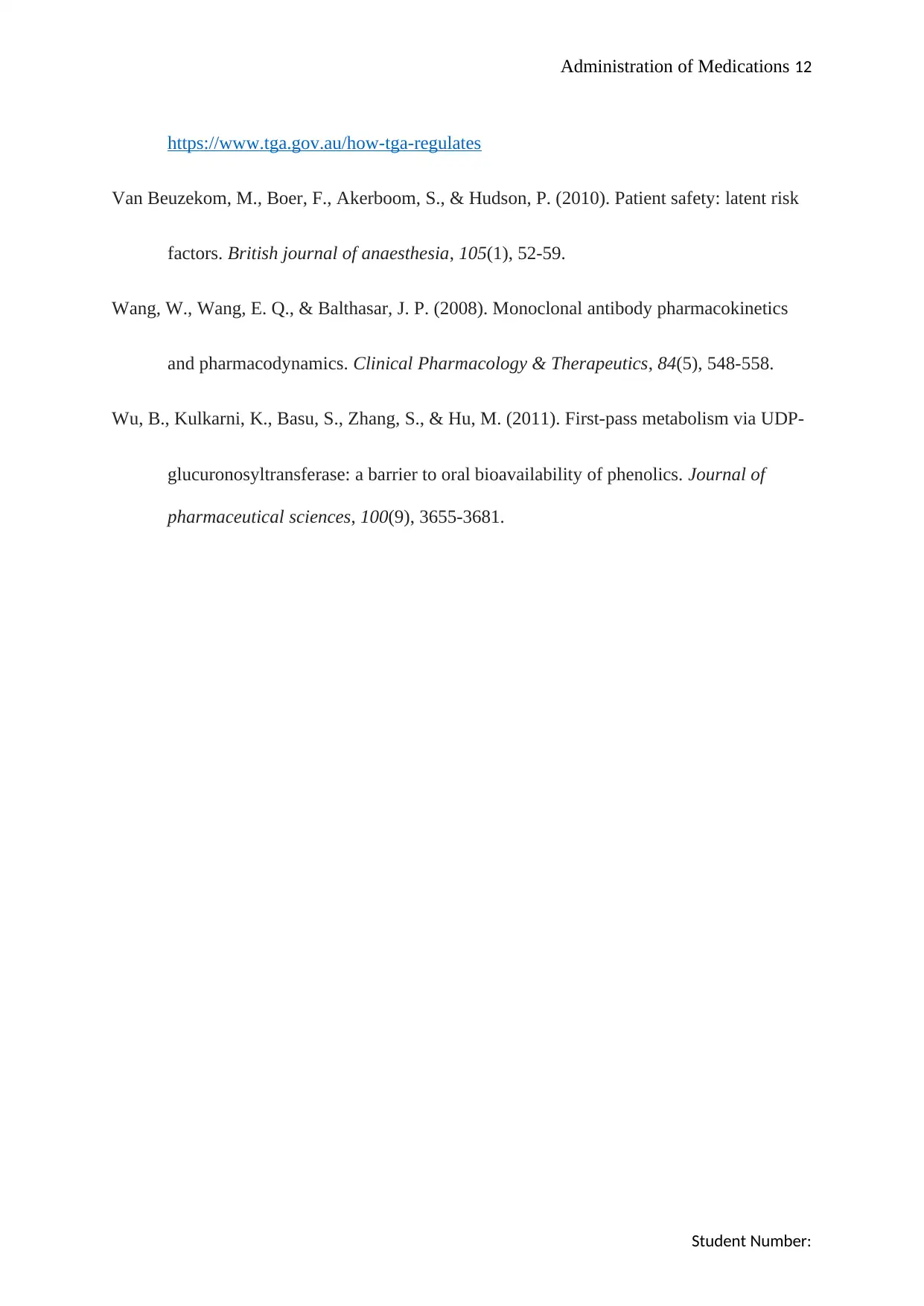
Administration of Medications 12
https://www.tga.gov.au/how-tga-regulates
Van Beuzekom, M., Boer, F., Akerboom, S., & Hudson, P. (2010). Patient safety: latent risk
factors. British journal of anaesthesia, 105(1), 52-59.
Wang, W., Wang, E. Q., & Balthasar, J. P. (2008). Monoclonal antibody pharmacokinetics
and pharmacodynamics. Clinical Pharmacology & Therapeutics, 84(5), 548-558.
Wu, B., Kulkarni, K., Basu, S., Zhang, S., & Hu, M. (2011). First-pass metabolism via UDP-
glucuronosyltransferase: a barrier to oral bioavailability of phenolics. Journal of
pharmaceutical sciences, 100(9), 3655-3681.
Student Number:
https://www.tga.gov.au/how-tga-regulates
Van Beuzekom, M., Boer, F., Akerboom, S., & Hudson, P. (2010). Patient safety: latent risk
factors. British journal of anaesthesia, 105(1), 52-59.
Wang, W., Wang, E. Q., & Balthasar, J. P. (2008). Monoclonal antibody pharmacokinetics
and pharmacodynamics. Clinical Pharmacology & Therapeutics, 84(5), 548-558.
Wu, B., Kulkarni, K., Basu, S., Zhang, S., & Hu, M. (2011). First-pass metabolism via UDP-
glucuronosyltransferase: a barrier to oral bioavailability of phenolics. Journal of
pharmaceutical sciences, 100(9), 3655-3681.
Student Number:
⊘ This is a preview!⊘
Do you want full access?
Subscribe today to unlock all pages.

Trusted by 1+ million students worldwide
1 out of 12
Related Documents
Your All-in-One AI-Powered Toolkit for Academic Success.
+13062052269
info@desklib.com
Available 24*7 on WhatsApp / Email
![[object Object]](/_next/static/media/star-bottom.7253800d.svg)
Unlock your academic potential
Copyright © 2020–2025 A2Z Services. All Rights Reserved. Developed and managed by ZUCOL.





